The big picture
BNB enters the final quarter of 2025 looking like a fully fledged platform asset rather than a residual exchange token. After an extended period of range-bound trading across the past few years, with little net progress through much of 2023 to mid-2025, the past three months have finally delivered notable growth, culminating in October’s new price records and a subsequent shake-out that tested conviction across majors and large caps alike. On the fundamentals side, throughput has stepped up materially after the Maxwell hard fork with average user fees remain unusually low for an L1. DeFi turnover on BNB Chain has been among the highest in the market during peak weeks. Token economics continue to lean deflationary via the Auto-Burn and BEP-95 mechanisms, linking on-chain activity to net supply over time. Governance remains the principal trade-off such as a permissioned validator set and a distribution in which top addresses hold outsized weight create concentration risk that must be underwritten by any long-only or market-neutral mandate on the asset. The sections that follow stitch the market action to the on-chain data, the technology roadmap, and the economic levers that matter most for allocators and builders.
Market performance and capitalisation in context
BNB’s breakout in early October represented a clear shift in its market cycle. After years of sideways movement, the token finally broke above $1,200 on 7 October, then extended higher into mid-October before calibrating downward. During 10–11 October, the market experienced a violent deleveraging which is roughly $19 b of positions were liquidated in about twenty-four hours, contributing to a sharp reversal and abrupt cooling in momentum. That drawdown aligned with macro shocks, including tariff news and risk-asset stress, and triggered a visible reset in daily indicators.
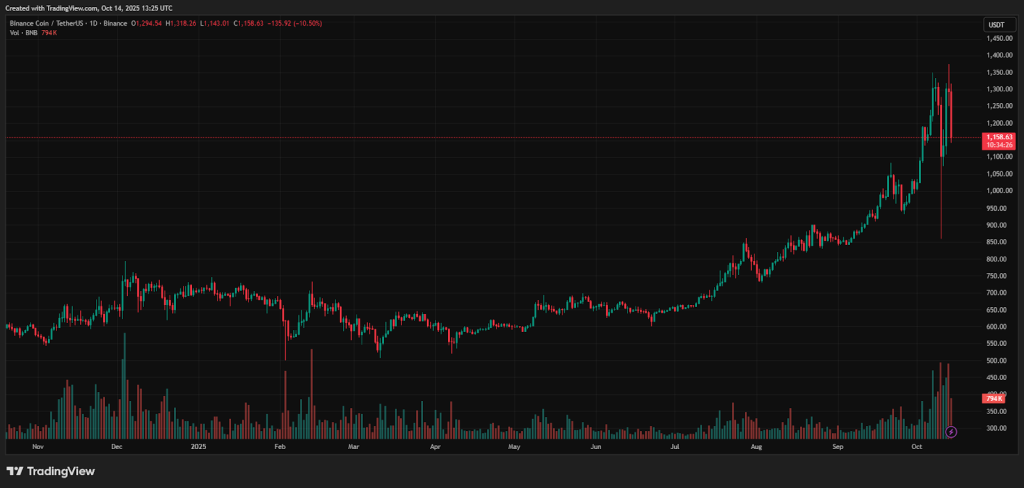
Source: https://www.tradingview.com/chart/?symbol=BINANCE%3ABNBUSDT
What stands out in this move is not just the high but how BNB behaved afterwards. Liquidity and depth looked robust. At the peak, BNB’s market capitalisation sat in the high-$170s to low-$180s billions, and it overtook XRP, ascending to the number three slot by market cap. Earlier in 2025, BNB and Solana’s valuations were closer in many snapshots, with SOL periodically narrowing or even flipping BNB in intra-day rankings. By October, that dynamic had reversed sharply. SOL sat in the $115–$120 b range, while BNB’s market value stretched considerably higher, widening the distance.
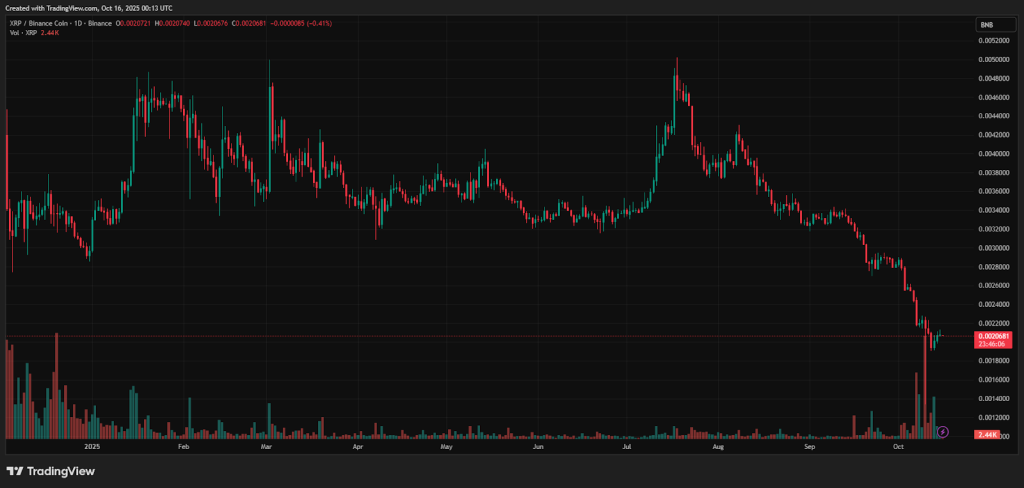
XRP/BNB Chart Nose Dive
Source: https://www.tradingview.com/chart/?symbol=BINANCE%3AXRPBNB
Viewed year to date, the revaluation is striking. BNB began 2025 in the $600–$700 range, seemingly constrained to second-tier growth. The run into October was more than technical, reflecting on-chain scaling, rising active addresses, increasing swap volume, and growing fee extraction. In other words, the price rise is anchored in throughput and utilitarian demand, not just hype.
Where valuation really stands
Current readings show BSC operating with deep liquidity and broad participation. TVL is $8.649b, supported by a $14.16b stablecoin base that keeps routing tight when flows pick up. Trading is led by spot at $5.064b of DEX volume, complemented by $368.46m in perps. Participation breadth remains high, with 3.09m active addresses. Capital is still leaning in, with $17.32m of net inflows. On the economics side, chain fees are $3.9m, app fees $7.67m, app revenue $4.96m, and chain revenue $398,153. Cross-chain liquidity is robust, with bridged TVL at $56.93b, and the view includes total raised of $10m. These figures are live “as of writing” and align with DefiLlama’s BSC chain metrics.
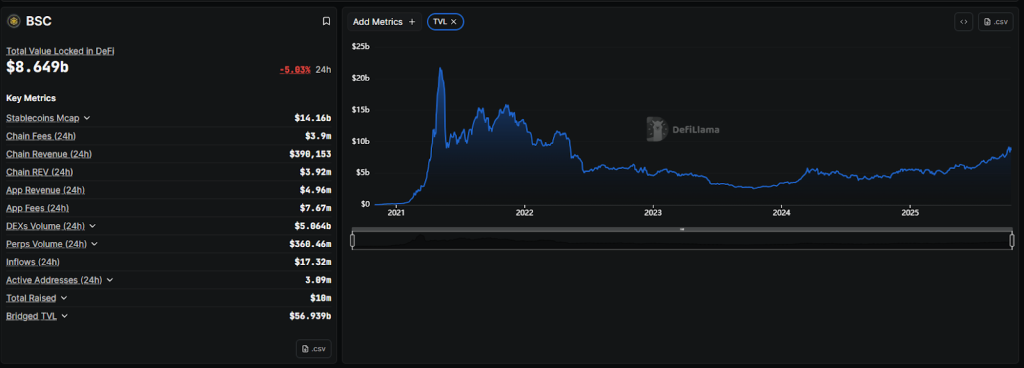
Source: https://defillama.com/chain/bsc
Set against the start of the year, the step-up is clear. On 1 January 2025, BSC TVL was approximately $5.523b and by 11 August 2025 it had risen to $7.156b. With TVL now $8.649b, that implies roughly +56% growth year-to-date, with most of the acceleration arriving from mid-year as activity broadened.
The mix of liquidity and throughput explains the execution quality users are seeing. A $14.16b stablecoin spine paired with $5.064b of spot turnover supports clean routing for size. Aggregators can split orders without blowing out price impact, and LPs can rebalance frequently without excessive slip. The day’s flow skews toward cash trading rather than leverage, roughly a 14:1 spot-to-perps ratio, which tends to dampen reflexive volatility and helps liquidity stick around once incentives taper. Multi-million fee prints alongside low user-level costs point to scale rather than congestion pricing, which is the operating band BSC targets for consumer-grade flows. With 3.09m active addresses, usage is broad enough that prints are not dominated by a single venue or product. Net inflows and large bridged balances round out the plumbing, suggesting funding pipes and cross-venue routes remain open.
If these conditions persist for weeks rather than days, a liquidity premium for BNB is defensible. The BEP-95 fee-to-burn link continues to chip away at float whenever volumes remain elevated, while user-facing costs stay low enough to keep consumer behaviour sticky. The weekly checks that matter are simple:
- TVL holding near or above the high-$8b band
- the stablecoin base stable to rising from $14b+
- DEX volumes in the multi-billion range with perps contributing but not dominating
- chain and app-fee prints remaining in the multi-million zone without a jump in per-transaction costs
- active addresses staying in the multi-million band.
As long as those lights stay green, depth and execution quality should remain strong, and economics should continue to accrue to BNB without sacrificing UX.
What changed in the demand mix
Two structural shifts define 2025’s demand composition for BNB Chain. The first is the return of retail trading at scale. Low nominal fees and near-instant confirmations, together with rapid listing and routing across PancakeSwap and other DEXs, created a fast lane for meme-season issuance. Activity begets activity in these cycles:
- creators launch into liquidity
- aggregators arbitrage pools
- perps track spot
- fee prints rise.
The loop is visible in the days when BNB Chain led all networks by 24-hour DEX turnover, with snapshots recording about $6.05b in swaps and chain fees above $5.5m in the same window.
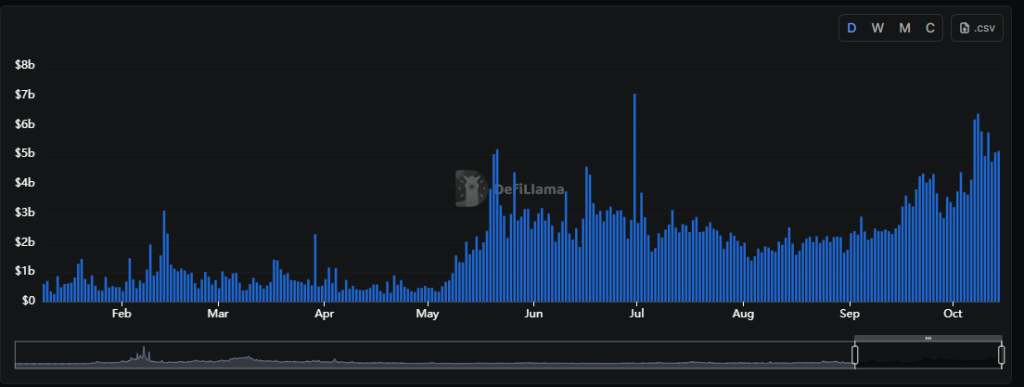
The second shift is a broader spread of reasons to show up on-chain, trading and non-trading alike. A timely example is decentralised social, since Farcaster support for BNB Chain brings SocialFi-style interactions, content primitives, and token routing into an EVM-compatible environment with aggressive fee and latency economics. On the trading side, the release of Aster and the Four.meme launchpad tightened the funnel between ecosystems, with perp traders who cut their teeth on Hyperliquid are increasingly active on BSC, while meme issuers and traders from Pump.fun on Solana have been launching and cycling liquidity through BSC’s rails. In parallel, tokenised-asset initiatives continue to include BNB Chain in 2025. This is strategically relevant for stablecoin depth, treasury products, and payments rails, even if primary issuance for many RWAs still sits on Ethereum today. The direction of travel matters for stickiness, since social, RWA, and cross-venue trading flows tend to be less sensitive to short speculative spikes than one-off mints or impulse swaps.
DeFi structure, TVL, and the role of liquidity
Total value locked is a blunt instrument, although it still signals where liquidity sleeps at night. BNB Chain’s TVL has been in the high-single-digit billions through mid-October. The headline figure is less instructive than the turnover on top of it. With ~$5.06 billion of DEX volume in a representative twenty-four-hour slice and nearly ~$38.83 billion over seven days, the capital velocity is high compared with the TVL base. That is consistent with a chain where retail is prominent in the flow mix and where incentives and listing cadence keep routing active rather than idle. PancakeSwap remains the anchor venue by both TVL and DEX share, but the broader DeFi stack includes perps venues, yield routers, and launch tools that all add to nominal volume.
Stablecoin depth is the second leg of market structure. A ~$14.16 billion stablecoin base on BSC in the same snapshot week does the unglamorous work of tightening spreads, improving route quality, and enabling deeper perps margining. Stablecoin float is also a behavioural tell. Rising floats during drawdowns suggest dry powder and a willingness to engage, with falling floats tell you capital is leaving the battlefield. BNB Chain’s steady float into October is part of why slippage remained tolerable even when volumes surged.
A word of caution is appropriate. High turnover on modest TVL is efficient when spreads and depth hold, yet it can invert during stress if LPs pull liquidity or if incentives fall away too quickly. The analytical task is to track seven-, fourteen-, and thirty-day retention by wallet cohort, repeat-trade intensity in DEX analytics, and the fraction of flow that converts to durable LP revenue rather than transient farm-and-dump activity.
Network usage, throughput, and fee behaviour
Raw throughput on BNB Chain has been exceptional in recent weeks. DefiLlama shows ~26,760,000 transactions and ~3,480,000 active addresses in twenty-four hours around mid-October. Those are near peak prints among general-purpose chains, and they explain why aggregate chain fees can still reach multi-million totals even when unit costs per transaction sit at cents. Throughput at this level changes UX expectations for consumer apps, which can deliver near-instant responses without the need for bespoke rollup infrastructure.

BNB Daily Transaction Count
Source: https://defillama.com/chain/bsc?tvl=false&transactions=true
Fees deserve careful parsing. The chain communicated a minimum gas price change to 0.05 gwei at the start of October, with validators and builders adopting the lower floor. BscScan’s gas tracker shows transaction templates with effective costs of cents, reflecting the combined effect of the gas-price floor and block-level dynamics after Maxwell. For users, the relevant metric is not the aggregate chain fee in dollars but the marginal cost to perform a swap, to post a message, or to mint an asset. With common actions priced around $0.01 in normal conditions, BNB Chain’s economics strongly favour high-frequency, small-ticket interactions that would be uneconomic on higher-fee L1s.
Congestion dynamics look manageable outside of burst windows. Pending-transaction charts have remained orderly, and confirmation latency is short enough that developers can design for immediate feedback rather than multi-second spinners. Lower slot times also reduce user-visible anomalies such as reorg-driven UI glitches in busy mints.
Upgrades, scalability choices, and architecture
The engineering story in 2025 has been about cadence and comfort-with-trade-offs rather than novelty for its own sake. The Maxwell hard fork is the centrepiece. Official BNB Chain materials and neutral explainers describe three BEPs behind the change:
- BEP-524 places block intervals at ~0.75 seconds
- BEP-563 improves validator network communication
- BEP-564 introduces smarter fetching and sync logic.
The net effect is faster block production, lower propagation delay, and more predictable behaviour under load. Equally important is what Maxwell builds upon. Earlier work, often grouped under the “Lorentz” label in community histories, had already tightened blocks to ~1.5 seconds from ~3 seconds, making 2025’s halving less risky than a single leap.
Shorter block intervals improve user-perceived responsiveness and compress the horizon for certain miner-extractable strategies, which in turn improves the fairness of price discovery for retail-heavy flows. Improved validator messaging reduces fork rates and lowers the chance of cascading slowdowns under peak issuance. For apps that need strong UI guarantees, such as order-book-like experiences or synchronous multiplayer logic, the difference between ~0.75 seconds and ~1.5 seconds is noticeable in practice.
Beyond L1, opBNB represents the network’s capacity extension. While not covered in the same primary sources above, the model is familiar which keeps EVM ergonomics, raise throughput targets by tuning gas limits and execution settings, and position the environment as the low-cost lane for consumer workloads. The benefit for the base chain is qualitative as much as quantitative. Having an associated execution environment with lower costs broadens the design space for builders without fragmenting the developer experience.
Economics: burns, float, and practical scarcity
BNB’s economic design is simple to describe and powerful in practice. Two burn channels reduce outstanding supply. The Auto-Burn is a formula-driven quarterly event that references block production and the average BNB price over the period, and it continues until the long-stated total-supply target of 100,000,000 BNB is reached. The BEP-95 mechanism burns a fixed share of gas fees in real time, directly linking activity to float reduction. In July, the ecosystem completed the 32nd Auto-Burn, permanently removing 1,595,599.78 BNB, worth roughly $1.02b at the time.
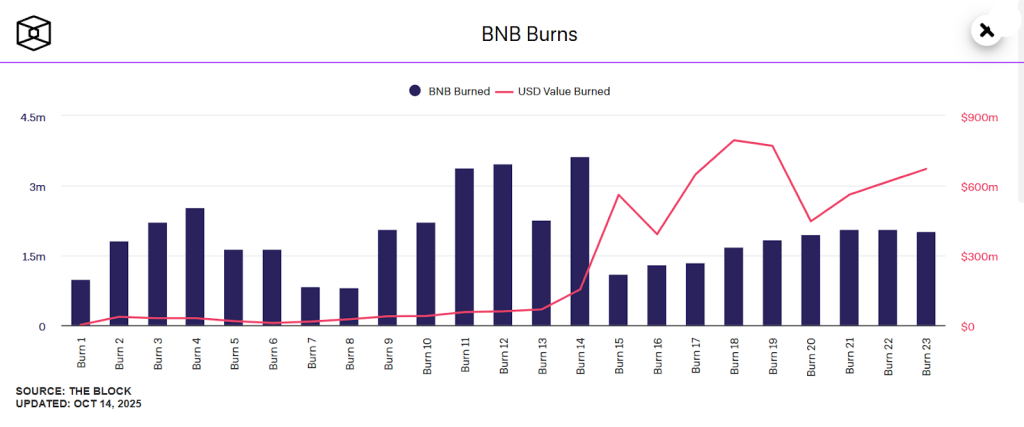
For holders and fundamental modellers, two practical consequences follow. During high-usage weeks, the BEP-95 channel becomes more meaningful, since every interaction contributes to permanent supply reduction. Over quarters, the Auto-Burn enforces discipline independent of exchange volumes, which was the point of the redesign years ago. Neither mechanism creates value on its own. They amplify value created by utility and usage by distributing it across a smaller base of units. The correct analogue is a conditional buy-back that accelerates when the business is busy and slows when the business is quiet.
Float remains substantial in absolute terms and adequate for large-cap mandates. Live snapshots place circulating supply near 139,000,000 BNB. Rich-list views of the holder base routinely show concentration at the top addresses that include exchange, bridge, and burn wallets, which matters for governance optics and for liquidity during stress. The correct response is not to ignore concentration but to price it such as use tighter de-risking triggers during policy shocks, diversify venues, and track whale-sized flows that could affect short-term depth.
Ecosystem growth: from DeFi to USD1-led stablecoin depth
DeFi remains the foundation of BNB Chain’s activity. PancakeSwap is still the flagship, with turnover that regularly reaches multi-billion prints in busy sessions. Perps venues and routing layers add to notional throughput and smooth execution at the edges. What has changed since prior cycles is the composition of demand. Consumer-grade issuance in meme-season, combined with smooth listings and routing, has turned BSC into a high-velocity trading venue. That is visible in the days when BNB Chain led all networks by DEX volume and posted the highest chain-fee totals for the period.
A major driver of this shift has been the arrival and rapid scaling of USD1, the fiat-backed stablecoin issued by World Liberty Financial. USD1 launched in 2025 on Ethereum and BNB Smart Chain. Within months, it built meaningful float and activity on BSC, supported by targeted initiatives that reduced user friction at the point of transfer. BNB Chain’s gas-free “carnival” covered all gas costs for USD1 and USDT transfers through mid-2025, which made on-chain stablecoin movement effectively free for users moving balances between wallets, centralised exchanges, and bridges. This mattered for retail and pros alike, since free transfers lower the threshold for arbitrage, LP rebalancing, and treasury routing.

As liquidity deepened, USD1 gained distribution and credibility signals. It listed on Binance in May, accelerated its market capitalisation above $1 b in late April, and continued to scale to the $2–3 b range by Q3–Q4, with a large share of its supply resident on BNB Chain. Several updates claimed that close to 90% of circulating USD1 sat on BNB Chain after the gas-fee initiatives went live, which aligns with the observed concentration of USD1 activity on PancakeSwap and other BSC venues. The result was a thicker stablecoin base that tightened spreads, improved route quality for DEX aggregators, and supported perps margining and settlement across the ecosystem.
Why USD1 matters for liquidity, payments, and protocols
For DeFi participants, the effect of USD1 is practical rather than purely narrative. More stablecoin float on BSC means deeper pools, lower price impact on large swaps, and faster capital cycling for LPs who rebalance frequently. For traders, gas-free transfers during the campaign period reduced the friction of moving collateral and PnL, which in turn encouraged tighter arbitrage loops and improved execution on volatile days. For builders, the presence of an additional, actively promoted dollar asset alongside USDT, USDC, and others diversified treasury rails and gave payment-centric apps a second or third path for deposits and withdrawals that did not rely on a single issuer.
Growth is not limited to trading alone. Farcaster support for BNB Chain brought decentralised-social primitives that generate high-frequency, low-value interactions, the sort of workload that benefits from cheap stablecoin transfers for tipping, micro-payments, and creator payouts. On the institution-facing side, USD1’s positioning as a fiat-backed, treasury-exposed coin, with custody partners and disclosures, aimed to make it usable for corporate flows and tokenised-asset rails on BSC. Even where heavy RWA issuance still clusters on Ethereum, the presence of USD1 on BNB Chain broadened the set of stable rails that treasuries and payment apps could use without leaving the ecosystem.
Airdrops and incentive programmes remain tools rather than strategies. The $45 m distribution initiatives widened the top of the funnel, and the gas-free stablecoin campaign did the same for movement and settlement. However, the real KPI is not wallets touched but repeat, unpaid usage after incentives end. If users keep routing through USD1 weeks after rebates and fee holidays, that is evidence of durable product-market fit rather than subsidy-driven activity.
Risk, concentration, and the governance question
Governance and concentration are central risks for BNB. The BNB Smart Chain validator design uses a limited-size, stake-elected active set rather than a fully open validator pool. A cohort of 45 validators competes for election, with 21 selected to produce blocks in each epoch. This structure provides real benefits in performance and upgrade agility, but it concentrates block-production rights more than permissionless, larger-set designs. The risk is not that the network will fail outright, but that external stakeholders may price in a governance discount relative to slower, more decentralised peers during periods of regulatory or policy pressure [Speculation]. The most credible mitigation is operational rather than rhetorical such as strengthening client diversity, improving incident responsiveness, and providing clear, transparent pathways for prospective validators to participate if they meet the required technical and staking criteria.

BNB network Topology
Source: https://docs.bnbchain.org/bnb-smart-chain/validator/overview/
Holder concentration feeds into the same conversation. The presence of large exchange, bridge, and burn wallets near the top of the distribution does not turn BNB into a single-beneficiary system, although it does create the possibility of sharper liquidity pockets during stress if several large holders move in the same direction. The professional response is to size positions with that tail in mind, to diversify across venues with independent risk, and to use option overlays when policy calendars are crowded.
The regulatory environment is the third leg of the risk stool. Macro shocks in October illustrate how quickly tariff headlines and cross-asset de-risking can flow through crypto leverage and into alt performance. Large exchanges and stablecoin issuers continue to face evolving scrutiny across jurisdictions, which can affect the pipes that feed on-chain activity. Those are ecosystem risks for every chain that relies on centralised bridges to fiat. They are more acute when an asset’s history and brand proximity link it, fairly or unfairly, to a single venue.
Outlook and scenario analysis
Scenario work should be humble in a tape that can wipe out $19 billion of positions in a day. The right use of scenarios is not to predict, it is to pre-commit to actions under specified readings of the dashboard.
Bullish path, three to six months. Activity remains elevated without outsized incentives.
- seven- and thirty-day DEX volumes hold in the multi-billion range
- stablecoin float on BSC remains above the low-teens billions
- aggregate chain fees stay healthy while user-facing costs remain cents
- SocialFi and tokenised-asset pilots convert to repeat usage.
Under these conditions, price can defend the high-$1,100s to low-$1,300s and attempt fresh discovery above the early October highs as risk appetite normalises.
Base path. The market digests the post-liquidation shock.
- DEX volume and fee prints step down but remain solid
- stablecoin float is steady
- developers continue to ship to BSC and opBNB
- repeats from airdrop cohorts are good but not spectacular.
In this path, consolidation in a ~$1,100–$1,300 band is plausible, with breakouts driven by market-wide liquidity rather than idiosyncratic catalysts.
Risk path. Policy headlines or infrastructure incidents push another wave of de-risking.
- DEX turnover fades
- stablecoin float contracts
- incentive fatigue becomes visible
- talent and launches rotate to competing ecosystems for a quarter.
In this case, price can test the low-$1,100s or worse, and liquidity pockets widen on bad days. Concentration and permissioned validators amplify the narrative headwind until the pipework looks calm again.
The thread across scenarios is that the technological work has already bought room for adoption. The question is now about persistence, composition of demand, and governance optics. The burn mechanics give tailwinds when activity is strong. They cannot manufacture activity when users are bored or when policy keeps them away.
Closing view
BNB’s 2025 story is one of scale, cost discipline, and credible engineering. The chain processes tens of millions of transactions per day with active addresses in the millions. It often posts the highest DEX turnover in the market during busy sessions. It does all of this with user-facing fees that remain around a cent for common actions. The Maxwell upgrade put the base chain on sub-second blocks, which shows up directly in UX, while the economic levers, namely Auto-Burn and BEP-95, keep float gliding lower whenever people use the network. Those are the hard pieces of any platform-asset case, and BNB has them today.
The trade-offs are equally clear. Validator design remains permissioned such as top-holder concentration is visible on rich lists and proximity to a major exchange keeps policy sensitivity in the foreground. The professional response is not hand-waving. It is position sizing with asymmetric de-risking triggers, venue diversification, options overlays into policy weeks, and a bias toward on-chain metrics that travel ahead of price.
As of mid-October 2025, the balance of verifiable evidence supports BNB as a platform in a leadership phase. The work for investors is to treat that leadership as a position to be monitored rather than a guarantee. If DEX volumes remain in the billions per day, if active addresses and transactions hold their lines without heavy incentives, if stablecoin float grows rather than shrinks, and if user fees stay in the cent range while aggregate fees remain healthy, the flywheel of usage, fees, and burn should continue to operate. If those indicators break, the case weakens quickly, and capital should be redeployed with discipline. That is the correct posture for a large-cap platform asset in a market that can erase $19 billion of leverage in a day and then reset.
